Sheliak, Beta Lyrae (β Lyr), is the primary component in a multiple star system located in the constellation Lyra. The system appears as a single star to the unaided eye. With a combined apparent magnitude of 3.52, it is the third brightest point of light in Lyra, after Vega and Sulafat. The Beta Lyrae system lies at a distance of about 960 light years from Earth. The main pair of stars comprises a close binary system that serves as a prototype for a class of variable stars known as the Beta Lyrae variables.
Star system
The Beta Lyrae system consists of six components. The brightest of these, Beta Lyrae A, is itself a multiple star system. It is composed of an eclipsing binary pair, designated Beta Lyrae Aa and a single star, Beta Lyrae Ab. The two eclipsing components are designated Beta Lyrae Aa1 and Aa2. They form a semidetached binary system, in which gas from the surface of one of the components is transferred to the companion.
Beta Lyrae Aa1 (formally known as Sheliak) has the stellar classification B8-8II, indicating a blue bright giant star, and Beta Lyrae Aa2 is believed to also be a B-type star.
The primary component, Beta Lyrae Aa1, is much larger, fainter and less massive than the secondary. Its estimated age is only 23 million years. It was once the more massive of the two stars and, due to its high mass, it was the first to evolve away from the main sequence. As it expanded and became a giant star, it has gradually transferred most of its mass to Beta Lyrae Aa2, at a rate of about 2 x 10-5 solar masses per year (1 solar mass every 50,000 years).
The inflowing gas has formed an accretion disk around the companion, which blocks the star’s light from view and makes its exact stellar type difficult to determine. The disk itself contributes about 20% of the system’s brightness. A 2018 study found a radius of 30.0 ± 1.0 solar radii for the outer rim of the disk.
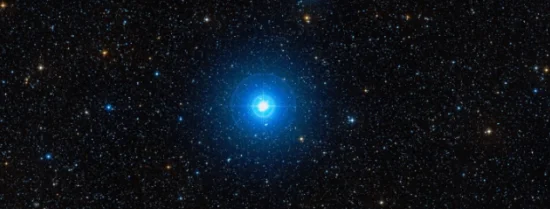
Sheliak (Beta Lyrae), image: Wikisky
The component Aa1 now has a mass about 2.97 times that of the Sun, while the companion has 13.16 solar masses. The primary star has a radius 15.2 times that of the Sun and the secondary is 6 times larger than our star. Both stars are exceptionally hot and luminous. Beta Lyrae Aa1 has a luminosity 6,500 times that of the Sun with a surface temperature of 13,300 K and Beta Lyrae Aa2 shines with 26,300 solar luminosities with an effective temperature of about 30,000 K.
The two stars orbit each other with a period of only 12.9414 days at a separation of 0.865 milliarcseconds. The mass transfer in the system has caused an increase in the system’s orbital period of 19 seconds per year. The stars are so close that their shapes are distorted into ellipsoids by mutual interaction.
The orbital elements of Beta Lyrae Aa were determined in 2008 based on images of the primary component and the companion’s accretion disk, taken with the CHARA Array interferometer and the Michigan InfraRed Combiner (MIRC).
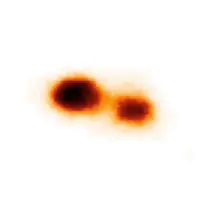
Beta Lyrae, image: Center for High Angular Resolution Astronomy (CHARA)
The brightness of Beta Lyrae varies from magnitude 3.25 to 4.36 with a period that corresponds to the system’s orbital period, 12.9414 days. The plane of the system’s orbit is almost aligned with the line of sight from our planet and, as the stars (Beta Lyrae Aa1 and Aa2) orbit, they regularly eclipse each other, causing the system’s brightness to vary.
The primary eclipses occur when the brighter primary component is eclipsed by the fainter secondary component (which is surrounded by an accretion disk). Unlike Algol-type variables, Beta Lyrae shows prominent secondary eclipses, when the brighter, less massive star passes in front of the companion. At its brightest, Sheliak is about as bright as the neighbouring Sulafat (Gamma Lyrae). At its faintest, it is the faintest of the stars that form Lyra’s distinctive parallelogram.
The Beta Lyrae system also shows irregular smaller amplitude variations, believed to be caused by changes in the accretion disk.
The variability of Beta Lyrae was discovered in 1784 by the English amateur astronomer John Goodricke, who had previously famously explained the mechanism for the variability of Algol in the constellation Perseus.
Beta Lyrae variables
The Beta Lyrae Aa system serves as the prototype for a class of variable stars known as the Beta Lyrae variables. The stars in this class include Tau Canis Majoris, Delta Pictoris, Mu1 Scorpii (Xamidimura), and Pi Scorpii (Fang).
Like Beta Lyrae, these stars are very close binary systems that periodically block each other’s light as they orbit. The light curves of these systems are always changing and it is nearly impossible to pinpoint when the eclipses begin and end. The eclipses occur very gradually because the mass transfer in the systems is so large that it envelops both components in a common atmosphere. In comparison, Algol-type eclipsing binary systems decrease in brightness with one or two minima, but for the most part their light is almost constant.
A possible third companion was detected in 2006. Designated Beta Lyrae Ab, the star is separated from the main pair by 0.54 arcseconds. It is believed to be a hot blue main sequence star of the spectral type B2-B5 V.
Various catalogues list five other stars under the designation Beta Lyrae – Beta Lyrae B, C, D, E, and F – but only Beta Lyrae B and F are believed to be physically associated with Beta Lyrae A. Beta Lyrae B is a main sequence star of the spectral type B7 V and Beta Lyrae F has the stellar classification G5. The two stars shine at magnitudes 7.19 and 10.10 respectively.
Other components have the stellar classifications B2 (Beta Lyrae C), K3V (D), and G5 (E). The Catalog of Components of Double & Multiple Stars (CCDM) lists visual magnitudes of 8.6, 13.0, 14.3, 9.9, and 9.9 for the components B, C, D, E, and F.
Beta Lyrae B is separated by 45.7 arcseconds from Beta Lyrae A and is easily visible in binoculars. It shines with 80 solar luminosities. Beta Lyrae F lies at an angular separation of 86 arcseconds. The components C, D, and E are separated by 47, 64, and 67 arcseconds respectively from the primary.
Facts
Beta Lyrae is one of the six stars in Lyra that outline the constellation’s recognizable lyre-shaped pattern. The other five stars are Vega (Alpha Lyrae), Sulafat (Gamma Lyrae), Epsilon Lyrae, Delta Lyrae, and Zeta Lyrae. The asterism represents the lyre of Orpheus, the legendary Greek poet and musician who tried to bring his wife Euridice back from Hades and later met a sad end at the hands of the Bacchantes.
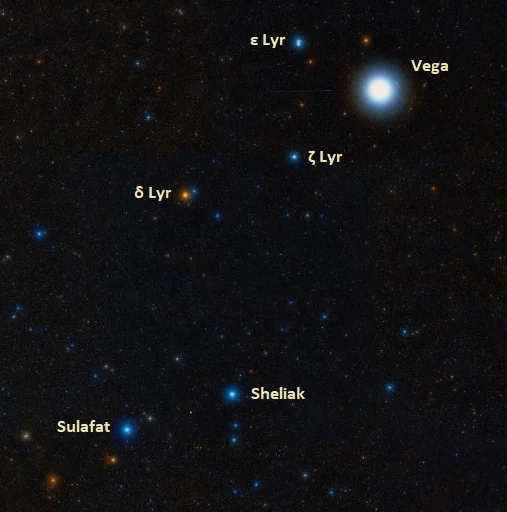
Lyra stars, image: Wikisky
In 2019, a study that analysed the astrometric and photometric data of stars around Beta Lyrae, obtained by the Hipparcos satellite and the Gaia space observatory, found a cluster of about 100 stars centred on Beta Lyrae. Aiming to discover any stars in this region of the sky that were physically associated with the eclipsing binary system, the researchers discovered a well-defined cluster of main sequence stars located at similar distances (about 290 parsecs), with similar proper motions. The cluster was named Gaia 8 in honour of the Gaia satellite project. The estimated age of the member stars is between 30 and 100 million years.
Name
The name Sheliak (pronunciation: /ˈʃiːliæk/) comes from Al Shilyāk, meaning “tortoise.” This was one of the Arabic names for the constellation Lyra. It has also been spelled Shelyak and Shiliak. Lyra’s association with the tortoise goes back to the Greeks. In Greek mythology, Hermes found the body of a tortoise on the bank of the Nile and discovered that he could produce music by striking the sinews. Using tortoiseshell, he created a lyre with three strings and gave it to Orpheus, a famous musician. After Orpheus’ passing, Zeus placed the lyre in the sky as the constellation Lyra.
The name Sheliak was approved by the International Astronomical Union’s (IAU) Working Group on Star Names (WGSN) on August 21, 2016. It formally applies only to the component Beta Lyrae Aa1.
The Chinese know Beta Lyrae as 漸台二 (Jiāntāièr), the Second Star of Clepsydra Terrace. Clepsydra Terrace is a Chinese asterism formed by Sheliak with Sulafat (Gamma Lyrae), Delta2 Lyrae, and Iota Lyrae. It represents water for an ancient water clock (clepsydra). The asterism is part of the Ox mansion, one of the northern mansions of the Black Tortoise.
Location
Beta Lyrae is very easy to find because it sits at the base of the parallelogram that outlines the celestial lyre. The constellation Lyra can be found using the Summer Triangle, a bright, large asterism that dominates the summer sky in the northern hemisphere. The Summer Triangle is formed by Vega, the brightest star in Lyra, with Altair and Deneb, the luminaries of Aquila and Cygnus. Deneb is recognizable as the star that also marks the top of the Northern Cross, while Altair is easily identified as the star flanked by two other relatively bright stars, Alshain and Tarazed. Vega marks the top of the celestial lyre and Sheliak is the western (right) of the two stars at the base of the asterism. The star to the left is Sulafat (Gamma Lyrae).
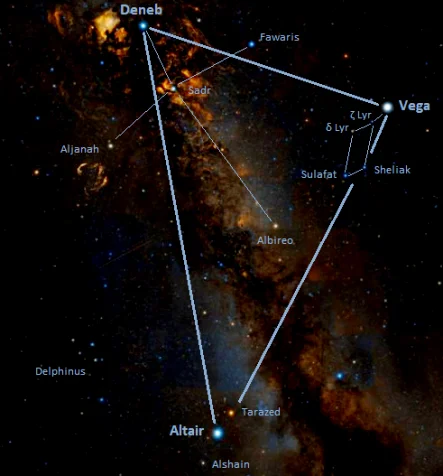
Lyra, the Summer Triangle and the Northern Cross, image: Wikisky
Sheliak and Sulafat can be used to find the Ring Nebula (Messier 57), one of the brightest and best-known planetary nebulae in the sky. The nebula appears roughly halfway between two stars. With an apparent size of 230 arcseconds and an apparent magnitude of 8.8, it can be observed in small telescopes. It lies 2,567 light years away.
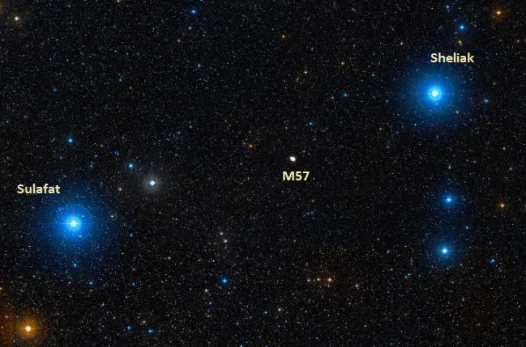
Sheliak (Beta Lyrae), Sulafat (Gamma Lyrae) and the Ring Nebula (Messier 57), image: Wikisky
Extending the imaginary line from Sheliak to Sulafat eastward leads to Messier 56, a bright globular cluster that appears halfway from Sulafat to Albireo at the base of the Northern Cross in Cygnus. The cluster has an apparent magnitude of 8.3 and its brightest stars are easily resolved in small telescopes. M56 lies approximately 32,900 light years away.
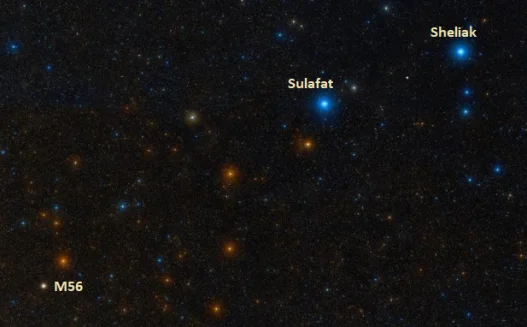
Sheliak, Sulafat and Messier 56, image: Wikisky
Constellation
Sheliak is located in the constellation Lyra. Lyra is one of the smaller constellations, stretching across 286 square degrees of the northern sky. Representing the lyre of Orpheus in Greek mythology, it is one of the 48 Greek constellations, first listed by Claudius Ptolemy in his Almagest in the 2nd century CE. It lies between the larger constellations Cygnus (the Swan) and Hercules.
Even though it is a small constellation, Lyra contains several well-known stars and deep sky objects. It is home to Vega, the fifth brightest star in the sky, the multiple star system Epsilon Lyrae (the Double Double), RR Lyrae, a prototype for a class of pulsating variable stars, and the variable red bright giant Delta2 Lyrae.
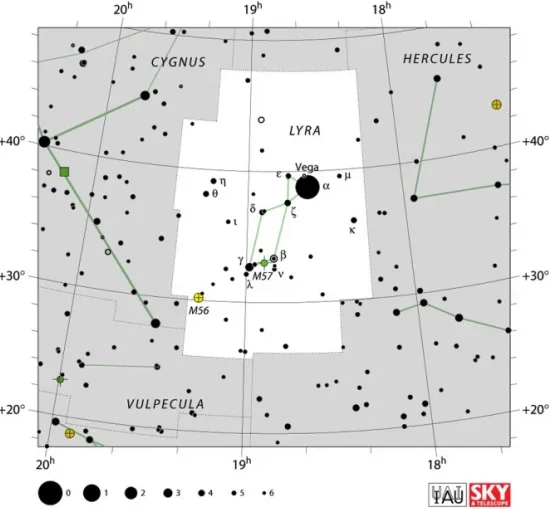
Lyra constellation map by IAU and Sky&Telescope magazine
In addition to the Ring Nebula (M57) and Messier 56, deep sky objects in Lyra include the irregular galaxy NGC 6745, the barred spiral galaxy IC 1296, the open cluster NGC 6791, and the planetary nebula Abell 46.
The best time of year to observe the stars and deep sky objects in Lyra is during the month of August, when the constellation stays high above the horizon in the evening sky. The entire constellation is visible from locations between the latitudes 90° N and 40° S.
The 10 brightest stars in Lyra are Vega (Alpha Lyrae, mag. 0.026), Sulafat (Gamma Lyrae, mag. 3.261), Sheliak (Beta Lyrae A, mag. 3.52), R Lyrae (mag. 4.00), Delta2 Lyrae (mag. 4.22), Kappa Lyrae (mag. 4.35), Zeta1 Lyrae (mag. 4.34), Theta Lyrae (mag. 4.347), Aladfar (Eta Lyrae, mag. 4.40), and Epsilon2 Lyrae A (mag. 4.59).
Beta Lyrae
| Spectral class | B6-8II + B |
| Variable type | Beta Lyrae |
| U-B colour index | -0.56 |
| B-V colour index | +0.00 |
| Apparent magnitude | 3.52 (3.25 – 4.36) |
| Constellation | Lyra |
| Right ascension | 18h 50m 04.7952472s |
| Declination | +33° 21′ 45.609978″ |
| Names and designations | Sheliak, Beta Lyrae, β Lyr, WDS 18501+3322 |
Beta Lyrae A
| Absolute magnitude | -3.82 |
| Distance | 960 ± 50 light years (290 ± 10 parsecs) |
| Parallax | 3.39 ± 0.17 mas |
| Radial velocity | 2.20 ± 0.7 km/s |
| Proper motion | RA: 1.90 ± 0.12 mas/yr |
| Dec.: -3.53 ± 0.20 mas/yr | |
| Right ascension | 18h 50m 04.7952472s |
| Declination | +33° 21′ 45.609978″ |
| Names and designations | Beta Lyrae A, β Lyr A, 10 Lyrae, HD 174638, HR 7106, HIP 92420, SAO 67451, SAO 67452, FK5 705, PPM 81887, BD+33 3223, AG+33 1690, GC 25847, GCRV 11294, ALS 19761, AAVSO 1846+33, JP11 3029, PLX 4353, UBV 21442, IRAS 18482+3318, 2MASS J18500479+3321455, TYC 2642-2929-1, ADS 11745 A, CCDM J18501+3322A, IDS 18464+3315 A, WDS J18501+3322Aa,Ab, WDS J18501+3322A |
Beta Lyrae Aa1
| Mass | 2.97 ± 0.2 M☉ |
| Luminosity | 6,500 L☉ |
| Radius | 15.2 ± 0.2 R☉ |
| Temperature | 13,300 K |
| Age | 23 million years |
| Surface gravity | 2.5 ± 0.1 cgs |
| Right ascension | 18h 50m 04.79525s |
| Declination | +33° 21′ 45.6100″ |
Beta Lyrae Aa2
| Mass | 13.16 ± 0.3 M☉ |
| Luminosity | 26,300 L☉ |
| Radius | 6.0 ± 0.2 R☉ |
| Temperature | 30,000 ± 2,000 K |
| Surface gravity | 4.0 ± 0.1 cgs |
| Right ascension | 18h 50m 04.79525s |
| Declination | +33° 21′ 45.6100″ |
Beta Lyrae B
| Spectral class | B7 V |
| Apparent magnitude | 7.19 |
| Distance | 1,080 ± 20 light years (333 ± 6 parsecs) |
| Parallax | 3.0065 ± 0.0542 mas |
| Radial velocity | −14 ± 5 km/s |
| Proper motion | RA: 4.373 ± 0.087 mas/yr |
| Dec.: −0.982 ± 0.098 mas/yr | |
| Right ascension | 18h 50m 06.7015034237s |
| Declination | +33° 21′ 06.622023790″ |
| Names and designations | Beta Lyrae B, β Lyr B, HD 174664, GC 25848, SAO 67453, GCRV 11295, BD+33 3224, AG+33 1691, PPM 81888, 2MASS J18500669+3321065, UBV 16021, TYC 2642-2930-1, Gaia DR2 2090687726329643392, Gaia DR1 2090687722033909504, ADS 11745 B, CCDM J18501+3322B, IDS 18464+3315 B, WDS J18501+3322B |
Beta Lyrae C
| Spectral class | B2 or B2p |
| Apparent magnitude | 13.07 |
| Parallax | 0.2384 ± 0.0151 mas |
| Proper motion | RA: -1.936 ± 0.024 mas/yr |
| Dec.: -1.824 ± 0.030 mas/yr | |
| Mass | 13.16 ± 0.3 M☉ |
| Luminosity | 26,300 L☉ |
| Radius | 6.0 ± 0.2 R☉ |
| Temperature | 30,000 ± 2,000 K |
| Surface gravity | 4.0 ± 0.1 cgs |
| Right ascension | 18h 50m 01.3564596503s |
| Declination | +33° 21′ 27.491037213″ |
| Names and designations | Beta Lyrae C, β Lyr C, HD 174639, 2MASS J18500135+3321275, UBV 16017, 2MASS J18500135+3321275, IDS 18464+3315 C, Gaia DR2 2090734696097241344, ADS 11745 C, CCDM J18501+3322C, IDS 18464+3315 C, WDS J18501+3322C |
Beta Lyrae D
| Spectral class | K3V |
| Apparent magnitude | 14.96 |
| Parallax | 0.8378 ± 0.0368 mas |
| Proper motion | RA: -0.108 ± 0.062 mas/yr |
| Dec.: -17.792 ± 0.074 mas/yr | |
| Right ascension | 18h 50m 09.5462881666s |
| Declination | +33° 22’ 09.286568376’’ |
| Names and designations | Gaia DR2 2090688104292041600, 2MASS J18500954+3322093, UBV 16018, UCAC3 247-141831, UCAC4 617-064606, ADS 11745 D, CCDM J18501+3322D, IDS 18464+3315 D, WDS J18501+3322D |
Beta Lyrae E
| Spectral class | G5 |
| Apparent magnitude | 9.77 |
| Parallax | 1.6209 ± 0.339 mas |
| Radial velocity | 1.4 km/s |
| Proper motion | RA: 1.649 ± 0.051 mas/yr |
| Dec.: 0.719 ± 0.053 mas/yr | |
| Right ascension | 18h 50m 01.1628657998s |
| Declination | +33° 22’ 34.941074165’’ |
| Names and designations | BD+33 3222, AG+33 1688, PPM 81884, GCRV 68732, GSC 02642-02933, 2MASS J18500116+3322350, UBV 16019, TYC 2642-2933-1, Gaia DR2 2090734730457641216, ADS 11745 E, CCDM J18501+3322E, IDS 18464+3315 E, WDS J18501+3322E |
Beta Lyrae F
| Spectral class | G5 |
| Apparent magnitude | 10.10 |
| Parallax | 3.5222 ± 0.0307 mas |
| Radial velocity | -16.83 ± 1.41 km/s |
| Proper motion | RA: 1.258 ± 0.047 mas/yr |
| Dec.: -3.793 ± 0.052 mas/yr | |
| Right ascension | 18h 50m 06.9524766762s |
| Declination | +33° 23’ 07.266259006’’ |
| Names and designations | BD+33 3225, AG+33 1692, PPM 81889, GCRV 68733, GSC 02642-01394, 2MASS J18500694+3323072, UBV 16020, TYC 2642-1394-1, Gaia DR2 2090735108414133120, ADS 11745 F, CCDM J18501+3322F, IDS 18464+3315 F, WDS J18501+3322F |